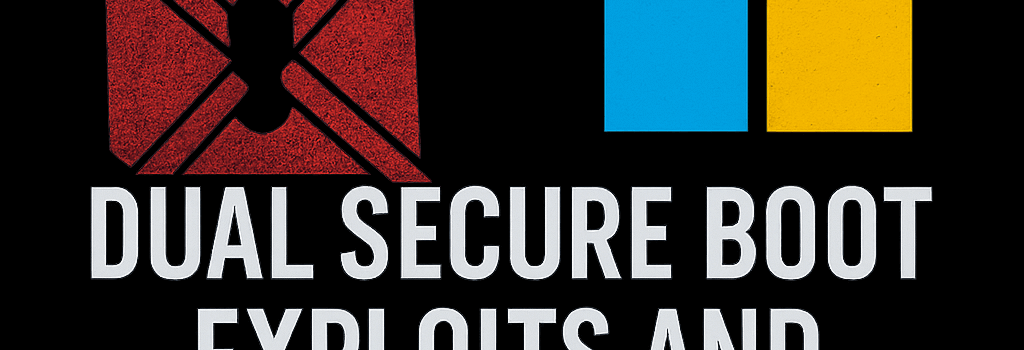Dual Secure Boot Exploits and Microsoft’s Partial Fix

Overview
In June 2025 researchers disclosed two separate Secure Boot exploits in active use that completely bypass UEFI protections. Secure Boot, a cornerstone of modern firmware security, uses a chain of trust to ensure only cryptographically signed code executes during system initialization. While Microsoft issued a patch for CVE-2025-3052, the second vulnerability, CVE-2025-47827, remains unaddressed—leaving a broadly trusted attack path open.
Exploit 1 CVE-2025-3052 The DT Research Shim Abuse
CVE-2025-3052 targets a firmware flashing utility developed by DT Research, intended for rugged field devices. Researchers at Binarly found that this module was signed by the Microsoft Corporation UEFI CA 2011 certificate and shipped pretrusted on over 50 manufacturer platforms. During the UEFI boot stage the RT_FlashTool module executes unconditionally if present in the EFI system partition. An attacker with physical or administrative access can invoke the tool to disable Secure Boot in NVRAM, then install a malicious UEFI driver that runs before the OS loader.
The vulnerability became publicly available via VirusTotal in 2024 and was digitally signed in 2022, suggesting wider distribution. Microsoft’s June update adds cryptographic hashes for 14 variants of the tool to the DBX revocation list, preventing the shim from loading. Red Hat, SUSE and other Linux vendors released parallel patches, updating shim blocklists on Enterprise kernels.
Binarly assigned an 8.2 out of 10 severity rating, contrasting Microsoft’s more conservative 3.1. Alex Matrosov, Binarly CEO, warns that one vendor misstep can ripple through the UEFI supply chain and urges continuous binary scanning with rapid DBX rollouts over annual BIOS updates.
Exploit 2 CVE-2025-47827 IGEL Flash Driver Bypass
The second exploit focuses on igel-flash-driver, a Linux kernel module used by IGEL OS thin clients. Signed by the same Microsoft UEFI CA, it fails to properly validate firmware image signatures. Researcher Zack Didcott demonstrated how an attacker with brief physical access can boot into IGEL recovery mode, leverage the flawed module to overwrite the boot loader, and chain-load unsigned kernels or malicious initramfs.
Eclypsium analysts highlight that any system trusting Microsoft Third Party UEFI CA is vulnerable until the signature is revoked. Jesse Michael of Eclypsium notes that the shim’s embedded key then approves the compromised rootfs, enabling stealthy persistence. To date Microsoft has not indicated plans to add the IGEL module to DBX, nor has it responded to inquiries.
Impact on Enterprise Security
These exploits underline systemic risks in the firmware trust chain. Enterprises relying on certified thin clients or rugged mobile devices may be unaware that trusted certificates extend implicitly to all UEFI modules. Government compliance programs, such as those in defense and healthcare, mandate Secure Boot but often lack granular monitoring of certificate revocations.
Evil maid scenarios are particularly dangerous in high-value environments. Once Secure Boot is disabled or bypassed, attackers gain early code execution, evading OS-level endpoint protections. In cloud data centers, compromised management nodes could deploy firmware attacks across dozens of servers.
Mitigation Strategies and Best Practices
- Maintain a tightly controlled UEFI db and DBX update process through MDM or BIOS management tools
- Implement measured and TPM-based attestation to detect unauthorized firmware changes
- Use hardware root of trust tokens to restrict access to NVRAM Secure Boot variables
- Conduct periodic firmware image binary scanning and integrity verification as part of CI/CD pipelines
- Limit physical access to critical systems and deploy chassis intrusion detection
Future Directions and Industry Recommendations
Security experts advocate for granular revocation mechanisms beyond full certificate blacklisting. Proposals under discussion at the Linux Foundation include a signed firmware bill of materials (SBOM) and automated shim signature transparency logs. NIST’s draft UEFI firmware guidelines also suggest embedding revocation metadata in KEK databases for real-time blocklisting.
Expert Opinions
It is imperative to shift from ad hoc annual updates to continuous firmware security hygiene, says Sandra Rivera, CTO of a major cloud provider. Having an automated pipeline to validate every UEFI binary can drastically reduce the window of exposure to new threats.
Conclusion
While Microsoft’s patch for CVE-2025-3052 closes one attack vector, CVE-2025-47827 remains a potent threat. Organizations must adopt rigorous firmware management processes, monitor revocation feeds, and enforce hardware-based attestation to preserve the integrity of the Secure Boot chain.